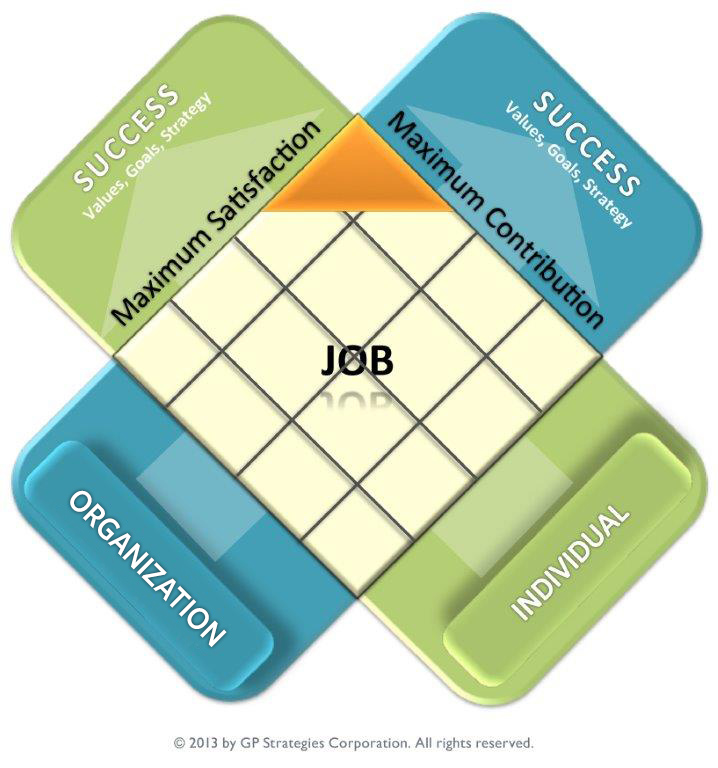3 Key Conversations Leaders Need to Have With Their People
by Katy BaileyTalent Management
Leaders must learn how to craft dialogues with intention and impact — for the benefit of the leader, the individual and the organization.
Whether it’s physical distance brought on by the remote and hybrid workforce, the impact of talent mobility amid a volatile market, or research on the importance of connection and belonging in the workplace, it’s clear that now more than ever, leaders need to be communicating with their people. But when time and schedules are tight, how do you make every minute count?
Effective communication is critical to building and maintaining successful relationships between leaders and their people. In fact, 2021 GP Strategies research identified leader communication as both the biggest success and the biggest stumble experienced by respondents throughout the course of their careers. In an increasingly dispersed workforce with more competition for talent than ever before, regular, ongoing, effective communication is key for both engagement and retention. To be maximally successful, leaders need to communicate for both competenceand connection; that is, they need to know what they’re talking about, show empathy and build rapport with those they lead.
In theory, the logic seems sound, but it can be helpful to examine this in practice as well. Consider your own career journey. Can you identify a leader whom you particularly enjoyed working for? Or the inverse where the working relationship wasn’t so great? Consider the role of communication, or lack thereof, in this relationship. How did this person communicate with you? How did it make you feel? How safe did you feel communicating with them?
These conversations and relationship-building efforts take time – and in a world where there never seems to be enough of it, this can present its own struggle for people leaders. Being intentional and strategic with your employee conversations can help alleviate this pain point.
Conversations and relationship-building efforts take time – and in a world where there never seems to be enough of it, this can present its own struggle for people leaders.
In this article, three key conversations for leaders will be covered: career conversations, performance conversations and engagement conversations. Though these are certainly not the only conversations leaders can have with their people, the intentional leveraging of these topics and touchpoints can provide a powerful basis for a successful and productive relationship between people leaders and their teams.
Prior to breaking down the three conversations, it might be helpful to introduce a model into which the conversations – and their focus areas – can be categorized.

GP Strategies’ X Model has been an industry standard for employee leadership and engagement for more than 40 years. The X Model considers two primary factors – contribution and satisfaction – and the roles of the individual and the organization within them. When maximum contribution and satisfaction are reached, that is full engagement – the apex of the employee experience.
Organizations are striving for success. This success is typically well-defined and documented, taking the shape of the organization’s values, goals and strategy. To get to that maximum level of success, the organization requires maximum contribution from each person working within it. Imagine a rowing team all rowing in unison to the finish line in a race – that’s maximum contribution. But what would that team look like if all members weren’t rowing? Or if some members were rowing, but not to their fullest potential? What if people were rowing in different directions or had no defined end point in sight?
The role of the leader, or coach, in that situation would be to help identify the barriers to maximum contribution, to clarify the end goal, and to be there for questions and support. The same is true for people leaders.
The role of a people leader, or coach, is to help identify the barriers to maximum contribution, to clarify the end goal, and to be there for questions and support.
Individuals are also on a path to success. The complexity of this path comes in realizing that success means different things to different people – it is an individualized equation. What drives or motivates one person is likely different from what drives or motivates a colleague on the same team. The vision of “success” may be ill-defined. As a leader, it is critical to know your people well enough to understand – and, in some cases, help them define – their vision of success. To know what “makes them tick” and what “ticks them off.”
Let’s return to the rowing team for a moment. Perhaps some members are on the team to fuel their competitive spirit – the thrill of victory. Others may be participating for the health- and wellness-related benefits of the sport. Still others enjoy the opportunity to travel to various races. When a leader understands what’s important to their people, it can be easier to identify opportunities that speak to that importance, and thus keep the team motivated and fulfilled.
With the X Model as a foundation in mind, let’s review the three key conversations and which elements of contribution and satisfaction they address.
Career conversations
Career conversations are perhaps among the most important, but least-frequently utilized, conversations between leaders and their employees.
The primary focus of a career conversation is maximum satisfaction — in other words, how happy is the employee within their current role? Career conversations can help:
- Clarify goals and aspirations.
- Discuss strengths and weaknesses.
- Brainstorm growth opportunities and development for future roles.
Managers often report shying away from career conversations for two primary reasons: They aren’t sure what to say, and they don’t have a formal promotion or raise to give a high-performing employee. But avoiding the conversation is not the answer. Research has shown time and again that most employees want to be talking about their career to their employer much more frequently than they do, and that the primary drivers for employees are not necessarily promotions. The chart below demonstrates this.
What Employees Want:
Source: GP Strategies 2021 research
Successful career conversations require an understanding of the individual employee’s skills, talents and aspirations. It can be tempting to focus solely on the first two elements – but it may be the case that what an employee is currently doing, or is good at, may not be what they really want to be doing. It might be helpful for leaders to ask:
- What matters to you?
- What are you good at?
- What do you enjoy doing?
- What are your career aspirations?
If you anticipate a conversation about growth opportunities, it can also be beneficial to strategize them prior to the conversation. What are the alternatives to “up”? Are there stretch assignments, development programs, or team- or project-based leadership opportunities to offer? Recognize that these opportunities may exist within or outside of your formal team structure.
Career conversations can be encouraged or required by the organization on a predetermined cadence (often biannually or quarterly). In the absence of a set schedule determined from above, leaders can benefit from identifying time and space to have career conversations with their team members.
Performance conversations
The focus of performance conversations is maximum contribution. Put in the context of the X Model, is your employee doing everything they can do to help the organization achieve success? If not, why not? And what can help them get to that point?
Performance conversations can help:
- Provide feedback on results and skills.
- Confirm goals, priorities and expectations.
- Discuss development for success in current role and upcoming projects.
Performance conversations can also address gaps in both skill and awareness. An employee may not fully understand the organization’s vision of success or how their role relates to it. They may find themselves being quite busy with daily tasks, but not actually working on the right things to drive success. It is the leader’s role to help translate this organizational strategy and gauge such alignment and understanding. Useful questions a leader may ask during a performance conversation include:
- What factor(s) do you feel have a primary impact on your performance?
- What does “success” in your role look like?
- What goals did you meet, and where did you fall short?
- Which of our company values did you live best in the last [month, quarter, etc.]?
Performance conversations can happen as part of a formal review or evaluation process, but they tend to be more successful when occurring more regularly. It is equally as important for leaders to recognize high performance as it is to address low performance. Many leaders focus primarily on the latter, but a balanced approach to giving constructive feedback and acknowledging high performance will help to create a culture where such conversations are welcomed and appreciated.
Engagement conversations
Engagement conversations take both maximum satisfaction and maximum contribution into consideration and they have a wealth of benefits to the individual and the organization. Engaged employees are more likely to report higher levels of workplace satisfaction and are more likely to remain with the organization. Given the high cost of turnover, engagement should be a primary focus area for leaders.
Engagement conversations can help:
- Gather information.
- Discuss challenges, working relationships, interests/energizers, opportunities to use talents and work environment.
- Clarify priorities and their connection to organizational success.
Through an effective engagement conversation, leaders can better understand what the enablers and barriers to success are for both contribution and satisfaction. It is important to note that this is not a time to give feedback to the employee, but rather simply to gather the relevant information pertinent to their contribution and satisfaction. To maximize engagement conversations, we recommend breaking them up into four parts: satisfaction, contribution,talent utilization/development and working together.
Questions a leader can ask during an engagement conversation include:
- What type of work energizes you/drags you down?
- What challenges are you facing with your role?
- Where would you like to grow?
- What would you like to stop/start/continue doing?
If applicable, engagement conversations should align with larger organizational efforts on employee engagement. If a survey has been administered, it is important to address findings, themes and trends with each individual and with the team as a whole.
This article has highlighted three intentional, defined conversation moments between leaders and their people – focusing on engagement, career, and performance. Regardless of the topic, there are a few key points for leaders to consider when planning and executing these conversations:
- To be most effective, leaders must first have a pulse on their own levels of contribution or satisfaction. Leaders are often looked at as simply a function of their roles and not individual contributors themselves. It is important to focus on oneself because as we say, a dead battery can’t jump-start another.
- All these conversations are made much more successful when there is strong trust and rapport present between the leader and their employee. This takes them from “check the box” moments to impactful touchpoints that affect both contribution and satisfaction. It is incumbent upon leaders to prioritize the development of these relationships.
- For each conversation, preparation is key. Leaders can prepare mentally or by using a checklist or template. If desired or needed, leaders can role-play conversations to help increase comfort and confidence.
- Leaders can tend to take on the onus of the conversation. Remember that the dialogue should be a two-sided exchange between the leader and their employee. Time and space should be given for the employee to contribute to, and in some cases lead, the conversation.
- Communication is not just about talking, but about effective listening as well. The best communicators can acknowledge, paraphrase, demonstrate empathy and ask follow-up questions that lead to the desired result.
- Allow the employee to prepare for the conversations by letting them know the topics and discussion points. Such transparency can help alleviate anxiety and benefit employees who require thought and preparation prior to the conversations.
- Each of these three key conversations can be a “both/and” moment – topics that are infused throughout regular touchpoints and also with a set point in time designated for their discussion.
Although each conversation is a defined moment in time, follow-up from these conversations is key. Employees need to feel that actions and commitments will be followed through on, and it is a great way to keep topics top-of-mind between formal conversations.
About the Author
Katy Bailey is a consultant, coach and learning strategist with a passion for developing organizations and their most important assets – their people. Her background as a consultant and facilitator, coupled with her professional experience in human resources and organizational development, equips her with a unique understanding of adult learning styles, strategic and sustainable approaches to program implementation, and the importance of aligning training initiatives to business objectives.
Contents of this article remain the property of the author and/or publisher.



